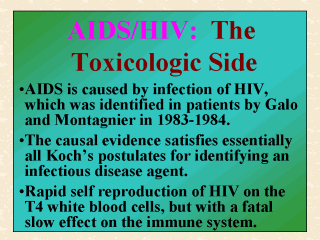| front |1 |2 |3 |4 |5 |6 |7 |8 |9 |10 |11 |12 |13 |14 |15 |16 |17 |18 |19 |20 |21 |review |
 |
As stated in the
last slide, the first cases of AIDS were recognized in the USA in the summer of 1981.
About three years later in 1984, Dr. Robert Gallo’s group at the U.S. National Cancer
Institute isolated a retrovirus in AIDS patients, which was initially called human T-cell
leukemia virus (HTLV) and now referred to officially as human immunodeficiency
virus (HIV). This HIV was the same virus as the one isolated eight months earlier,
in September 1983, by Dr. Luc Montagnier and his colleagues at the Pasteur Institute in
Paris. In the 1980s even before Galo and Montagnier’s time, several related viruses and
several strains of HIV were identified, including those in the African green monkey and
the Asian macaque monkey. There is strong evidence supporting HIV as the causative agent of AIDS. All of Koch’s postulates for identifying an infectious disease agent were essentially satisfied, including the evidence that a number of healthy health care workers have been infected by accident via needle sticks (Stine, 1993). However, molecular virologist Dr. Peter Duesberg at the University of California at Berkeley is among the few who have believed to this day that HIV does not play a direct role in AIDS. While exerting its adverse effects rather slowly, HIV is a retrovirus as it can reverse the flow of information. When present, they reproduce themselves rapidly and attack selectively the immune system, primarily by attaching to the surface of the T4 white blood cells and eventually killing them. HIV can also be found in the nervous system, intestine, and bone marrow of some patients. |